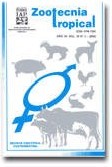
|
Zootecnia Tropical
Instituto Nacional de Investigaciones Agrícolas Venezuela
ISSN: 0798-7269
Vol. 27, No. 4, 2009, pp. 363-372
|
 Bioline Code: zt09039
Bioline Code: zt09039
Full paper language: English
Document type: Research Article
Document available free of charge
|
|
|
Zootecnia Tropical, Vol. 27, No. 4, 2009, pp. 363-372
| es |
Factores de riesgo asociados a la tripanosomosis bovina en explotaciones ganaderas de Venezuela
Suárez, Claribel; García, Francisco; Román, Diego; Coronado, Alfredo; Perrone, Trina; Reyna, Armando & Parra, Nereida
Resumen
El objetivo de esta investigación fue identificar los factores de riesgo asociados a la tripanosomosis bovina
en explotaciones ganaderas de Venezuela. Se procesaron 1.675 muestras para el estudio de la infección activa
(IA) y 1.572 para serología, procedentes de 49 explotaciones ganaderas distribuidas en 4 regiones geográficas:
llanos (orientales y occidentales), sur del lago, centro-occidental y andina. La IA se determinó por la técnica
de microcentrifugación y la seropositividad a Trypanosoma vivax

fue detectada mediante las técnicas de
inmunofluorescencia indirecta y el ensayo inmunoenzimático ELISA. A través de una encuesta epidemiológica
se recabó información sobre tipo racial, edad, sexo, propósito, manejo y tratamiento tripanocida (principio activo
y frecuencia de aplicación). Se obtuvo una tasa de infección activa general de 5,9% y una seropositividad general
de 33,1%. Los siguientes parámetros (factores de riesgo) tuvieron asociación positiva con la seropositividad:
ausencia de aplicación de drogas tripanocidas (OR=2,62), uso de diminaceno (OR=1,87), grupo etario mautes(as)
(OR=1,48) y adultos (OR=1,41), tipo racial Bos indicus

(OR=1,80), propósito carne (OR=1,29) y manejo semiintensivo
(OR=1,40). Los factores asociados negativamente (efecto protector) fueron: aplicación de drogas
tripanocidas (independientemente del principio activo; OR=0,38), aplicación de isometamidio (OR=0,35),
frecuencia de uso de drogas tripanocidas de forma regular con intervalo de 4 a 6 meses (OR=0,62) y mayor
a 6 meses (OR=0,33), grupo etario becerros (as) (OR=0,39), tipo racial mestizos de Bos taurus

por B. indicus
(OR=0,63) y manejo extensivo (OR=0,71). Estos factores deben ser considerados en la implementación de planes
estratégicos de control en áreas endémicas de esta enfermedad.
Trypanosoma vivax, tripanosomosis, factores de riesgo.
|
| |
| en |
Risk factors associated with the bovine trypanosomosis of livestock farms in Venezuela
Suárez, Claribel; García, Francisco; Román, Diego; Coronado, Alfredo; Perrone, Trina; Reyna, Armando & Parra, Nereida
Abstract
The aim of this study was to identify the risk factors associated with bovine tripanosomosis in cattle ranches in
Venezuela. There were processed a total of 1.675 blood samples for active infection study and 1.572 for serology,
collected in 49 cattle herds from livestock farms scattered in nine states of the country and 4 different geographical
regions: east and west plains, south lake, central-west, and andean. Microcentrifugation technique was used to
detect active infection by Trypanosoma vivax

, while seropositivity to this hemoprotozoan was detected by both
the indirect immunofluorescence technique and the ELISA immunosorbent assay. Through an epidemiological
survey, information on the racial, age, gender, purpose, management, and tripanocidal treatment (active ingredient and frequency of application) was gathered. There was a general active infection rate of 5,9% and an overall
33,1% seropositivity. The following parameters (risk factors) were positive associated to seropositivity: lack of
implementation of trypanocidal drugs (OR=2,62), use of diminazeno (OR=1,87), age group heifers(OR=1,48)
and adults (OR=1,41), racial Bos indicus

(OR=1,80), purpose meat (OR=1,29), and semi intensive handling
(OR = 1,40). Factors associated negative (protective effect) were trypanocidal drug application (irrespective
of the active ingredient) (OR=0,38), implementing isometamidium (OR=0,35), frequency of use of drugs on a
regular basis with trypanocidal drugs at interval of 4 to 6 months (OR=0,62) and longer than 6 months (OR=0,33),
age group calves (OR=0,39), racial mixed breed Bos taurus

x B. indicus (OR=0,63), and extensive management
(OR=0,71). These factors should be considered in the implementation of strategic plans to control this disease in
endemic areas.
Trypanosoma vivax, trypanosomosis, risk factors
|
| |
© Copyright 2009 - Zootecnia Tropical
Alternative site location: http://www.sian.inia.gob.ve/repositorio/revistas_ci/ZootecniaTropical/ztindice.htm
|
|
